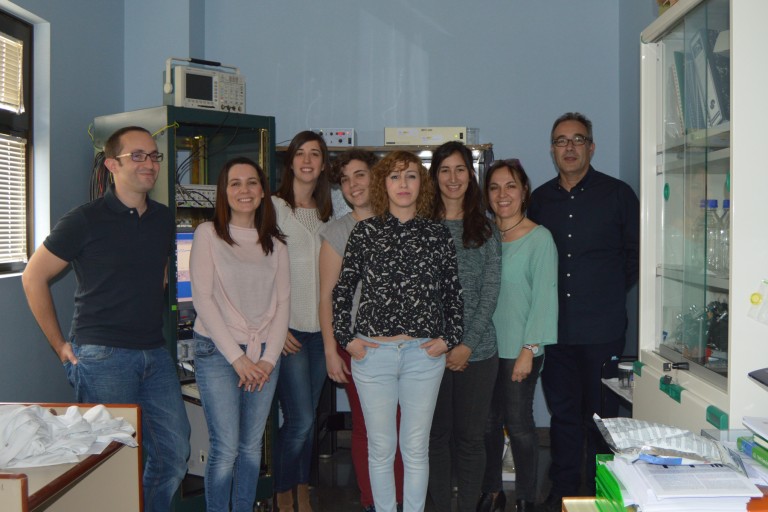Dc. Nadal Group
Estrogen Receptors and Diabetes
Our research group works to understand how the pancreas (and more specifically, its endocrine part) adapts to pregnancy and to obesity. We focus on the role of estrogens in these processes, mainly through the ERα, ERβ, and GPR30 receptors. We study how exposure to specific endocrine disruptors with estrogenic activity (such as bisphenol A) can increase the risk of obesity, diabetes mellitus, or both. More specifically, we study how exposure to these compounds during pregnancy affects glucose regulation both in mothers and in their descendants. The results obtained up to date indicate that bisphenol A is a type 2 diabetes mellitus risk factor.



About Us
- Principal Investigators:
Ángel Nadal Navajas
Juan Martínez Pinna - Doctoral Fellows:
Reinaldo Sousa dos Santos Regla
M. Medina-Gali - Predoctoral Fellows:
Ignacio Babiloni Chust
Roberto Sempere Navarro - Technicians:
María Luisa Navarro Salomé
Ramón Beatriz Bonmatí

What Do We Research?
The World Health Organization (WHO) defines diabetes mellitus as “a chronic disease, which occurs when the pancreas does not produce enough insulin, or when the body cannot effectively use the insulin it produces.” Likewise, the WHO indicates that, in 2014, 9% of the world’s population over 18 years of age suffered from diabetes. In Spain, the figures are just as alarming. The di@bet.es study established that 13.8% of Spain’s adult population had diabetes, and it also highlighted that approximately half of this percentage did not know about it. The two main types of diabetes mellitus are type 1 and type 2. Type 1 diabetes affects 5% of diabetics, and is usually diagnosed at an early age. It is caused by the destruction of the β-cells, which produce insulin, the only hormone in our bodies capable of lowering blood glucose levels. If the body does not produce insulin, it must be administered exogenously in order to maintain healthy glucose levels.
Type 2 diabetes is the most common type of diabetes, and it accounts for 90% of all diabetes cases. People who suffer from type 2 diabetes can secrete insulin, but the cells in their bodies do not respond to it in the same way as those of non diabetic persons. That is, it is due to an impairment of the action of insulin in the body; the cells in their bodies are insulin resistant. Initially and for some time thereafter, the pancreas adapts to this resistance by increasing the number of β-cells, as well as the production and secretion of insulin in response to glucose. As a result, there is an increase in the quantity of blood insulin, which reaches excess levels (hyperinsulinemia). At the beginning of the disease, these excess levels are sufficient to compensate the insulin resistance of the cells in the body, and blood glucose levels stay within an acceptable range. Unfortunately, the adaptation of β-cells eventually begins to fail. At this point, these cells do not produce nor secrete enough insulin to compensate insulin resistance. Consequently, blood glucose levels rise above healthy levels: diabetes develops.
Why this state of insulin resistance and hyperinsulinemia takes place in some people but not in others is a complex matter. Genetic predisposition is important, but environmental factors are as important or more important than genetic factors. There are many environmental factors that increase our probability of becoming diabetic, but obesity is undoubtedly the most important one. 70% of obese people will suffer from type 2 diabetes at some point in their lives. Our group researches how the environment increases our predisposition to obesity and to type 2 diabetes. When we talk about the environment, we are referring to all factors except genetic ones. Thus, the environment includes mainly the following factors: nutrition, physical activity, the drugs we might take, microbiota (our microflora), other diseases we might have, and, of course, pollution. Our group’s interest is focused on this last factor, and more specifically, in a special type of pollution that involves chemical compounds known as endocrine disruptors. According to the US Endocrine Society, endocrine disruptors are “exogenous chemicals, or mixtures of chemicals, that interfere with any aspect of hormone action”. Hormones act on our cells and, therefore, on our bodies by biding to specific proteins, their receptors. Scientific evidence indicates that some endocrine receptors, even in low doses such as the ones found in our environment, bind to these hormone receptors and alter their response. Disruptors can cause either the activation of these receptors (just like hormones themselves or even more so) or their blocking (thus preventing the normal functioning of hormones, since they occupy the receptor through which hormones carry out their functions). They can also alter the number of hormone receptors of a specific cell, and even directly increase or decrease the level of hormones (as has been observed in the case of sexual hormones such as testosterone and estrogens).
These effects, depending on the dose of the disruptor and on the time of our life at which they occur, will trigger a change in our body, making us, for example, more vulnerable to specific diseases such as obesity and diabetes. In this sense, it has been proven that being continually exposed to given disruptors during adulthood can increase the risk of type 2 diabetes. In this case, the process is reversible; if the exposure diminishes or disappears, we can recover our health. However, if the exposure occurs during fetal development, the consequences can be much more serious. A lot of the processes that take place during the development of the embryo and the fetus are regulated by the action of hormones, among other factors. One of these processes is the formation of organs. Therefore, the alteration of hormone action can cause serious permanent changes in organ formation and development. These effects can have consequences during our whole lives. These consequences are complex and difficult to predict, since they appear years after our birth and after exposure to disruptors. Identifying the physiological changes resulting from early life exposure to endocrine disruptors is therefore essential to understand how exposure to these compounds increases the risk of obesity, diabetes, or both.
Our group has carried out experiments with the endocrine disruptor bisphenol A (BPA). Until recently, bisphenol was considered a weak estrogen that acted through the ERα and ERβ estrogen receptors. Its binding to ER caused ER binding to DNA, where estrogen receptors regulate the expression of various genes. Using genetically modified mice, we discovered that bisphenol is a potent estrogen when it acts via ERα and ERβ through non-classical signaling pathways. Thus, we were able to explain, at least partially, the observed response to low concentrations of bisphenol. In 2006, our work with animal models showed that exposure to bisphenol A in adult mice produced resistance to insulin and hyperinsulinemia. Some years later, we published a study showing that exposure during pregnancy alterated glucose metabolism both in mothers and in their descendants. Now that we have characterized these effects, we are interested in learning how bisphenol produces them. We would like to understand the molecular changes that take place in pancreatic cells (specifically, in islet of Langerhans α-cells and β-cells), as well as the possible role of nuclear receptors in these changes.
Diabetes and endocrine disruptors are considered a serious and urgent problem both by the WHO and the United Nations. Through legislation, governments try to regulate the possible exposure of the population to these endocrine disruptors. In this sense, it is essential to know the mechanisms of action and their possible role in the contraction of diseases in order to carry out this regulation. Therefore, understanding the cause-effect relationship between exposure to disruptors and metabolic diseases is of great social importance. By identifying the endocrine disruptors that produce diabetes mellitus and obesity, we could help decrease the proportion of people who suffer from these diseases. We cannot easily control genetic risk factors, but we might be able to improve the control of environmental factors such as endocrine disruptors.
Publications
- Bisphenol-S and Bisphenol-F alter mouse pancreatic β-cell ion channel expression and activity and insulin release through an estrogen receptor ERβ mediated pathway.Marroqui L, Martinez-Pinna J, Castellano-Muñoz M, Dos Santos RS, Medina-Gali RM, Soriano S, Quesada I, Gustafsson JA, Encinar JA, Nadal A.(2021) Chemosphere.265:129051. doi: 10.1016/j.chemosphere.2020.129051.
- Oestrogen receptor β mediates the actions of bisphenol-A on ion channel expression in mouse pancreatic beta cells.Martinez-Pinna J, Marroqui L, Hmadcha A, Lopez-Beas J, Soriano S, Villar-Pazos S, Alonso-Magdalena P, Dos Santos RS, Quesada I, Martin F, Soria B, Gustafsson JÅ, Nadal A.(2019) Diabetologia. Sep;62(9):1667-1680. doi: 10.1007/s00125-019-4925-y.
- Molecular mechanisms involved in the non-monotonic effect of bisphenol-a on ca2+ entry in mouse pancreatic beta-cells.Villar-Pazos S, Martinez-Pinna J, Castellano-Munoz M, Alonso-Magdalena P, Marroqui L, Quesada I, Gustafsson JA, Nadal A.(2017) Sci Rep. Sep 18;7(1):11770. doi: 10.1038/s41598-017-11995-3.
- Endocrine-disrupting chemicals and the regulation of energy balance.Nadal A, Quesada I, Tudurí E, Nogueiras R, Alonso-Magdalena P.(2017) Nat Rev Endocrinol. May 19. doi: 10.1038/nrendo.2017.51.
- Maternal Exposure to Bisphenol-A During Pregnancy Increases Pancreatic β-Cell Growth During Early Life in Male Mice Offspring.García-Arévalo M, Alonso-Magdalena P, Servitja JM, Boronat-Belda T, Merino B, Villar-Pazos S, Medina-Gómez G, Novials A, Quesada I, Nadal A.(2016) Endocrinology. Nov;157(11):4158-4171.
- EDC-2: The Endocrine Society’s Second Scientific Statement on Endocrine-Disrupting Chemicals.Gore AC, Chappell VA, Fenton SE, Flaws JA, Nadal A, Prins GS, Toppari J, Zoeller RT.(2015) Endocrine Reviews. 36(6): E1-E150.
- Bisphenol-A Treatment During Pregnancy in Mice: A New Window of Susceptibility for the Development of Diabetes in Mothers Later in Life.Alonso-Magdalena P, García-Arévalo M, Quesada I, Nadal A.(2015) Endocrinology. 156: 1659–1670.
- Exposure to Bisphenol-A during Pregnancy Partially Mimics the Effects of a High-Fat Diet Altering Glucose Homeostasis and Gene Expression in Adult Male Mice.García-Arevalo M, Alonso-Magdalena P, Rebelo Dos Santos J, Quesada I, Carneiro EM, Nadal A.(2014) Plos One. 9: e100214.
- Antidiabetic actions of an ERβ selective agonist.Alonso-Magdalena P, Ropero AB, Garcia-Arevalo M, Soriano S, Quesada I, Muhammed SJ, Salehi A, Gustafsson JA, Nadal A.(2013) Diabetes. 62:2015-2025.
- Rapid insulinotropic action of low doses of bisphenol-A on mouse and human islets of Langerhans: role of estrogen receptor β.Soriano S, Alonso-Magdalena P, García-Arévalo M, Novials A, Muhammed SJ, Salehi A, Gustafsson JA, Quesada I., Nadal A.(2012) PLOS One. 7 (2): e31109.





